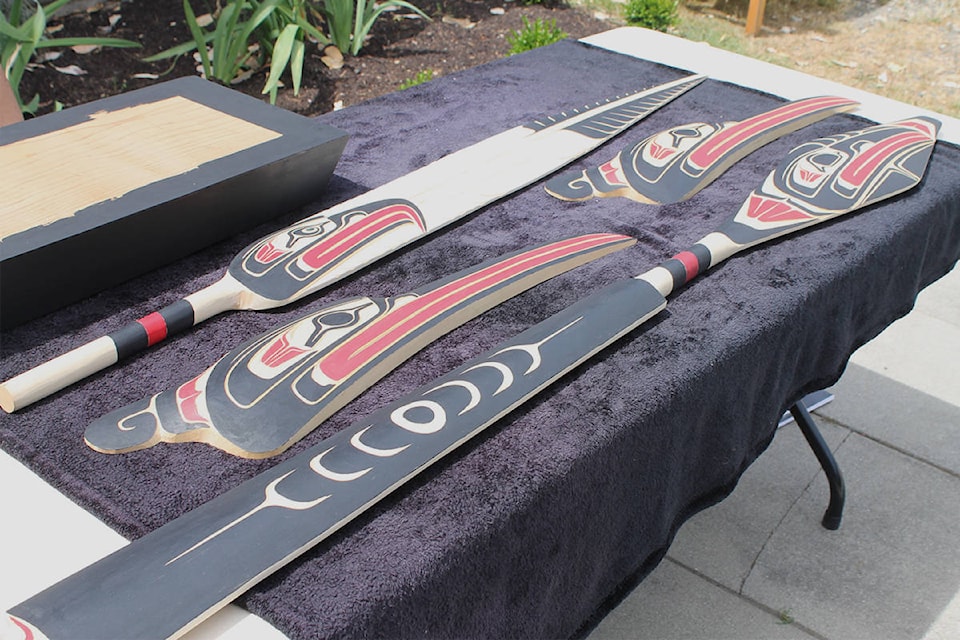Joe Bob sits at the entrance of the Parksville Museum as the smell of fry-bread fills the air. It’s the first day of the Coast Salish Artisan Market.
Bob’s artwork is displayed in front of him, and he thumbs through a copy of Hilary Stewart’s Looking at Indian Art of the Northwest Coast. It’s a slim text, but it’s dense with information and illustration. He explains the symbols and creatures common to Coast Salish art to the small cluster of people gathered around him.
Bob has been carving for 38 years. He’s from the Snaw-Naw-As, or Nanoose, First Nation, but he first learned to carve from his uncle, William Goode of the Snuneymuxw.
READ MORE: ‘Supernatural Eagle’ art casts watchful gaze over RDN boardroom
For Bob, carving is a practice that helps him remember who he is. To absorb knowledge from those who come before him and pass it along to those who follow.
“It’s a way of life, basically, practice. It helps me stay grounded, no matter who I am and where I’m from,” said Bob.
He learned his craft from several different teachers across Vancouver Island. What he didn’t learn directly from others, he taught himself by sitting at the Royal BC Museum and studying the art displayed there for hours.
Other artists he met there would encourage him to keep going.
“Just to never give up, and keep practising, and practising our way in a sense there, too. Always to continuously learn, and always to practise what we do have,” said Bob.
Laid out on the table in front of him at the Parksville Museum are a prayer feather and a paddle carved from white pine, as well as two hummingbirds carved from yellow cedar.
They are done in what he describes as a traditional Coast Salish style mixed with a northern influence.
Inscribed into the black of the paddle’s handle is a circle flanked by three crescents on either side. This pattern is also replicated in the prayer feather. Bob says the symbols are used to represent the belief that their ancestors are watching over.
“You’re always protected by your teachings, and how you practice them,” said Bob.
All four pieces mix black and red together. Bob says the opposing colours often represent male and female. On a larger conceptual scale, they also represent the duality of nature and the balance of life. On both the paddle and the feather, two black bands surround one red band.
“You’re always going to be surrounded by the black road, the darkness of life. The red road is the positivity of life. And you keep on practicing that, to keep balance in your life,” said Bob.
READ MORE: Food, local plant knowledge spreading with Snaw-Naw-As in Nanoose Bay
The prayer feather has many uses. Its main function is for prayer, smudging, and as a talking stick.
Each person in a circle holds the feather while they speak, and then passes it. If the feather gets passed around a circle once, that’s a sign of communication. When the feather goes around twice, that’s a sign of conflict.
It’s also held when speaking in front of a crowd, to help the presenter communicate without getting overwhelmed by the pressure of public speaking.
To Bob, the practice of carving is linked with memory, understanding and tradition. It’s all part of a larger practice of culture, learning and passing down knowledge.
“We come from an oral history. Continue to practice that, oral history, same with our songs and dances,” said Bob.
“To keep it alive. Because there’s so much that’s already gone, in its own manner, but if you keep practicing it, somewhere along the line, someone is going to come along and say ‘okay, that’s part of our way.’”
Joe Bob will display his work as part of the interactive art exhibit Soft Shore: where land and water meet at the McMillan Arts Centre, which opens July 6.
